Llama (Lama glama) and alpaca (Vicugna pacos) are two of animals from South America. Both llama and alpaca belong to the camelidae family as camels.
Although it belongs to the same family as camels, they don’t live in the desert. Most of them are live in the Andes Mountains. Here are specific kind of desert animal you must know. Having a long neck, thick fur, and a funny face makes alpaca and llamas become two animals that are difficult to distinguish.
These two animals are equally used feathers for making yarn wool. But if you pay attention, there are some striking differences between llama and alpaca. What are the differences?
1. Physical Differences
Llama and alpaca have differences in some parts of their bodies. One of them is the ear. Llama ears are longer in shape resembling a banana, while the alpaca ears are pointed and shorter than the llama’s.
Besides, llama’s body size is bigger and taller compared to alpaca. Adult llamas can reach 120 cm tall with a weight of 113 kg. Because of their larger body, llamas are more widely used to carry heavy items on the way inland.
Alpaca has a smaller body size, only 91 cm tall, with an average weight reaching 65 kg. Alpaca’s body size makes it the smallest Camelidae family.
2. Appearances
Alpaca is often considered to be funnier and cuter with a blunt nose and lots of hair on his head, whereas the llama looks elegant with a longer nose and face shape compared to alpaca.
Alpaca tends to keep the body cleaner compared to the llama. The llamas are known as pleasant and calm guard animals, while the nature of the alpaca is the opposite, which is more restless.
Because of the gentle nature of these llamas, sometimes some alpaca breeders also maintain llamas as guardians for their alpacas. Besides, llamas are also easier to train because they are calmer, more patient, and independent.
3. Different Utilization
Llama’s large and strong body size makes it a “horse” in the Andes Mountains. Llama can carry a load of up to 30 percent of its body weight. Although llama also has fur, it is not as thick as alpaca and is not overgrown with thick hair on the head.
Alpaca is used as a raw material for making wool. This fine fiber, derived from Alpaca fur, makes it the best quality wool with a variety of colors. Alpaca fur is known to be softer when used as wool yarn compared to llama fur.
It is because alpaca hair have more delicate fibers. Llama hair looks coarser because llamas have two layers of fur. Llama fur that is used for wool yarn is fur on the inner layer.
Alpaca fur is also often used as a substitute for fleece, especially for people who have allergies to fleece. Speaking of fleece, here’s a little history lesson: how people farm sheep long ago. The fleeces used to be a glamorous fashion for many rich people. Interested in farming sheep? Apparently, you can be farming your sheep in free range method.
4. Their Personality Provides a Different Role
Not only humans but animals also have their personalities and unique characteristics, as well as Llama and Alpaca. As explained earlier, llamas are animals that are confident and brave and can live independently so that they can protect themselves.
At the same time, alpaca is accustomed to living in groups and has a gentle and shy character. Usually, a group of alpaca consists of one male, several females, and their children. Some Alpaca breeders often make llama as herd keeper.
5. Llama is More Expressive Than Alpaca
There is one interesting fact about llamas. Did you know that llamas are famous for spitting? It’s a bit funny though if we think about it, but there are reasons you need to take it seriously. It may coincidentally spit on your face. Does llama spit on your face? Reasons and how to avoid it.
Apparently, alpaca is an animal who also likes to spit when they feel disturbed by the presence of humans or other animals. However, llama spits more often if it feels even slightly disturbed, it can also kick while alpaca is softer and only aggressive when after giving birth.
Although Llama and Alpaca are different, both can be crossed to produce quality descent. The result of crossing is called Huarizo with physical characteristics smaller than the llama and has longer hair fiber than alpaca.
You can have both llama and alpaca as your pet if you live in America, but you must pay attention to things what should be done if you want to make the wild animal being a pet.
Those are some of the differences between llama and alpaca. I hope we won’t get confused the next time we see a llama and an alpaca, either in a picture or real.

